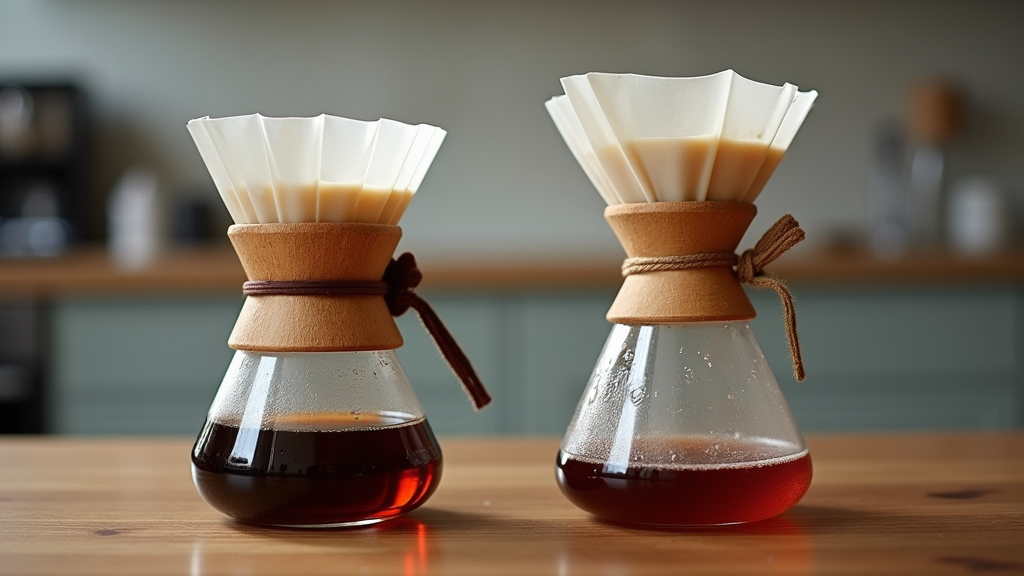Table of Contents
- Understanding How a Chemex Coffee Maker Works
- Understanding How a Chemex Coffee Maker Works: The Basics
- How Does a Chemex Coffee Maker Work: A Detailed Guide
- Maintaining Your Chemex: Cleaning for Optimal Brewing
- Brew Comparison: Understanding How Chemex Brewing Differs
- Exploring Alternative Uses of a Chemex Coffee Maker
- Understanding How the Chemex Coffee Maker Works: Final Thoughts
Understanding How a Chemex Coffee Maker Works

Chemex Design: Overview and Brewing Importance
The Chemex coffee maker, invented in 1941 by chemist Peter Schlumbohm, is renowned for its elegant design and ability to produce exceptionally clean coffee. Its construction features a single piece of borosilicate glass shaped like an hourglass, complemented by a wooden collar and tied with a leather string for safe handling. The Chemex utilizes specially designed paper filters, which are thicker than standard filters, to remove sediment and oils, resulting in a smooth, clear brew. Each Chemex cup is typically measured at 5 fluid ounces (148 ml). The Chemex offers a unique brewing experience that emphasizes flavor clarity and aroma, making it a favorite among coffee aficionados.
Chemex History: From Invention to Modern Popularity
First produced in 1941 in Chicopee, Massachusetts, by the Chemex Corporation, the Chemex quickly gained recognition for its functional design and the quality of coffee it produced. Over the years, the Chemex has maintained its popularity, particularly within specialty coffee circles. While the fundamental design has remained consistent, various sizes and filter options have become available to cater to different brewing needs and preferences, solidifying its place in coffee brewing history.
Chemex Brewing: What You’ll Learn in This Guide
In this guide, you’ll learn core concepts about the Chemex, including understanding its unique design, mastering the brewing process, and appreciating the advantages of its specialized filters. We will provide step-by-step brewing instructions to help you consistently brew excellent coffee. You’ll also find valuable cleaning tips to maintain your Chemex and troubleshooting advice to address common issues that may arise during brewing.
Understanding How a Chemex Coffee Maker Works: The Basics
Key Definitions in Chemex Coffee Brewing Outline
**Expert Insight:** Mastering the Chemex involves understanding the ‘bloom’ and ‘extraction’ processes for optimal flavor. While the classic Chemex offers manual control, the Ottomatic provides automation, but regardless of the model, a burr grinder and coffee scale are essential for consistent, high-quality brews.
When exploring how a Chemex coffee maker works outline, understanding a few key terms is essential. The ‘bloom’ refers to the initial saturation of the coffee grounds with hot water. This allows carbon dioxide to escape, preparing the grounds for optimal extraction. ‘Extraction’ is the process of dissolving soluble compounds from the coffee grounds into the water, creating the final brew.
Core Principles Outlined for Chemex Coffee Brewing
The Chemex brewing method relies on two core principles. First, it employs gravity-driven brewing, allowing for a highly controlled extraction process. Second, the use of thick paper filters ensures a clean, sediment-free cup of coffee, highlighting the nuances of the coffee beans.
Essential Components for a Chemex Coffee Maker Outline
To properly understand how a Chemex coffee maker works outline, you need to know the required components. These include the Chemex coffee maker itself (the 6-cup and 8-cup versions are most popular), Chemex filters (or compatible generic ones), a burr grinder, a gooseneck kettle, fresh coffee beans, and a coffee scale (which is highly recommended for precision).
Key Features to Consider in a Chemex Outline
Several key features contribute to the Chemex’s unique brewing process. The primary aspects include its borosilicate glass construction, the iconic wooden collar, and rawhide tie. Secondary aspects to consider are the filter thickness and the Chemex size (capacity). It’s also important to note variations like the classic Chemex versus the Chemex Ottomatic (an automatic version), and the different wooden collar colors available.
How Does a Chemex Coffee Maker Work: A Detailed Guide

Gathering Materials for Chemex Coffee Brewing Outline
To begin brewing with your Chemex, gather these essential items:
- Chemex coffee maker
- Chemex filter
- Burr grinder
- Gooseneck kettle
- Freshly roasted coffee beans (within 2-4 weeks of roasting)
- Kitchen scale
- Timer
Before starting, boil filtered water to approximately 205°F (96°C) and grind your coffee beans to a medium-coarse consistency, similar to sea salt. Water quality significantly impacts the final brew, so always use filtered water. A typical coffee-to-water ratio is between 1:15 and 1:16, but adjust to your preference.
Step-by-Step Chemex Coffee Brewing Process Outline
Follow these instructions for a perfect Chemex brew:
Maintain a consistent water temperature around 200°F (93°C) and use a slow, controlled pouring technique for even saturation. Avoid pouring water directly onto the filter to ensure a clean taste. Common mistakes include grinding the coffee too finely, uneven pouring leading to inconsistent extraction, and skipping the bloom phase.
Advanced Chemex Brewing Techniques and Optimization Outline
Elevate your Chemex brewing with these expert tips:
- Experiment with different coffee-to-water ratios to fine-tune the taste to your liking.
- Try various coffee beans, selecting those suited for a medium to coarse grind, to explore a range of flavors.
- Adjust the grind size based on the brew time; use a finer grind for faster extraction and a coarser grind for slower extraction.
For optimization, use a thermometer to ensure accurate water temperature and pre-wet the filter evenly to promote consistent water flow. If you encounter a clogged air channel, ensure that the thicker side of the filter is positioned in the air channel. Use a metal stick to prevent the filter from sticking if needed. Under-extracted coffee can be improved by using a finer grind or hotter water, while over-extracted coffee benefits from a coarser grind or cooler water.
Maintaining Your Chemex: Cleaning for Optimal Brewing
Daily Chemex Cleaning: Hand Washing Instructions
Cleaning your Chemex coffee maker after each use is crucial for maintaining its performance and the quality of your brew. Hand washing is the recommended method to ensure longevity.
Use these steps for daily cleaning:
- Hand wash the Chemex with warm water, soap, and a soft-bristled brush.
- Avoid the dishwasher, as the heat and harsh detergents can damage the glass and wood collar.
- Use non-scented soap to prevent any lingering flavors from affecting future brews.
Deep Cleaning Your Chemex: Removing Coffee Residue
Over time, coffee oils and mineral deposits can build up in your Chemex, affecting the taste of your coffee. Periodically deep cleaning your Chemex is essential.
Here’s how to deep clean your Chemex:
- Use vinegar or a dedicated coffee maker cleaning solution.
- Ensure thorough rinsing to remove any cleaning solution residue, which can negatively impact the taste of your coffee.
Chemex Long-Term Care: Safe Storage Practices
Proper storage is vital to prevent damage to your Chemex coffee maker. Treat it with care to preserve its condition.
- Store the Chemex in a safe place where it won’t be knocked over or exposed to extreme temperatures.
- If the wooden collar becomes damaged, replace it to maintain the Chemex’s structural integrity and aesthetic appeal.
Brew Comparison: Understanding How Chemex Brewing Differs

Chemex vs. Other Pour-Over Coffee Methods
The Chemex stands out in the pour-over coffee world, offering a unique brewing experience compared to other popular methods. Let’s examine how it stacks up against some common alternatives.
- Chemex vs. Hario V60: The Chemex features an all-in-one borosilicate glass carafe and dripper, while the Hario V60 typically uses a separate ceramic or plastic dripper placed on top of a coffee cup or server. More significantly, Chemex filters are notably thicker than V60 filters. This results in a cleaner, brighter cup of coffee with less sediment and fewer oils passing through. The V60, with its thinner filters, often produces a cup with more body and a slightly different flavor profile.
Chemex vs. Hario V60: The Chemex features an all-in-one borosilicate glass carafe and dripper, while the Hario V60 typically uses a separate ceramic or plastic dripper placed on top of a coffee cup or server. More significantly, Chemex filters are notably thicker than V60 filters. This results in a cleaner, brighter cup of coffee with less sediment and fewer oils passing through. The V60, with its thinner filters, often produces a cup with more body and a slightly different flavor profile.
Chemex Versus AeroPress: Defining Brewing Differences
While both the Chemex and AeroPress are known for producing excellent coffee, they achieve this through vastly different mechanisms.
- The Chemex relies on gravity and a thick paper filter for a clean extraction, resulting in a lighter-bodied, nuanced cup. The AeroPress, on the other hand, uses pressure to force water through the coffee grounds, creating a fuller-bodied, more concentrated brew. Depending on your preference, you may find that Chemex suits a delicate, aromatic coffee while AeroPress excels with bolder, richer roasts.
The Chemex relies on gravity and a thick paper filter for a clean extraction, resulting in a lighter-bodied, nuanced cup. The AeroPress, on the other hand, uses pressure to force water through the coffee grounds, creating a fuller-bodied, more concentrated brew. Depending on your preference, you may find that Chemex suits a delicate, aromatic coffee while AeroPress excels with bolder, richer roasts.
Chemex Versus French Press: Exploring Filtration Impacts
The most significant difference between the Chemex and the French Press lies in their filtration methods, leading to distinct final products.
- The Chemex uses a paper filter, which traps almost all of the coffee grounds and oils, resulting in a clean, sediment-free cup with a lighter body. In contrast, the French Press uses a metal mesh filter, which allows fine sediment and oils to pass through. This results in a heavier-bodied coffee with a richer, more textured mouthfeel. If you prefer a clean, crisp cup, the Chemex is the better choice. If you enjoy a bolder, more robust coffee with a bit of sediment, the French Press is the way to go.
The Chemex uses a paper filter, which traps almost all of the coffee grounds and oils, resulting in a clean, sediment-free cup with a lighter body. In contrast, the French Press uses a metal mesh filter, which allows fine sediment and oils to pass through. This results in a heavier-bodied coffee with a richer, more textured mouthfeel. If you prefer a clean, crisp cup, the Chemex is the better choice. If you enjoy a bolder, more robust coffee with a bit of sediment, the French Press is the way to go.
Exploring Alternative Uses of a Chemex Coffee Maker
Chemex Coffee Maker for Brewing Tea and Infusions
While primarily known for brewing exceptional coffee, the Chemex’s design lends itself well to preparing other beverages. You can easily brew loose leaf tea in a Chemex by adjusting the steeping time to suit the type of tea you’re using. For delicate green teas, a shorter steeping time is best, while black teas can handle a longer infusion.
Cold Brew Coffee Preparation with a Chemex Brewer
The Chemex is also an excellent tool for making cold brew coffee. The slow filtration process extracts a smooth, less acidic concentrate. Simply combine coarsely ground coffee with cold water in the Chemex, let it steep in the refrigerator for 12-24 hours, and then remove the grounds and enjoy a refreshing cold brew.
Using a Chemex for Unique Beverage Infusions
Experiment with infusing water with fruits, herbs, and spices using your Chemex. This is a great way to create refreshing and flavorful drinks. Add sliced cucumbers, mint leaves, or citrus fruits to the Chemex, pour in cold water, and let it infuse for a few hours in the refrigerator. The Chemex’s filter will keep any solids out of your final beverage.
Understanding How the Chemex Coffee Maker Works: Final Thoughts

Recap: Chemex Coffee Maker Brewing Essentials
In summary, the Chemex stands out as a pour-over method celebrated for producing exceptionally clean and flavorful coffee. Its unique filter and glass construction contribute to this distinct brewing experience.
Mastering the Chemex involves understanding key elements such as water temperature, grind size, and pouring technique. Precision in these areas is crucial for extracting the best possible flavor from your coffee beans.
Continuing the Chemex Coffee Maker Brewing Journey
The world of Chemex brewing is one of continuous learning and refinement. Don’t be afraid to experiment with different beans, grind settings, and pouring methods to discover your perfect cup.
Ultimately, the Chemex is more than just a coffee maker; it’s an invitation to slow down, appreciate the process, and savor the rich, nuanced flavors of expertly brewed coffee. Embrace the art of Chemex brewing and enjoy the journey!

